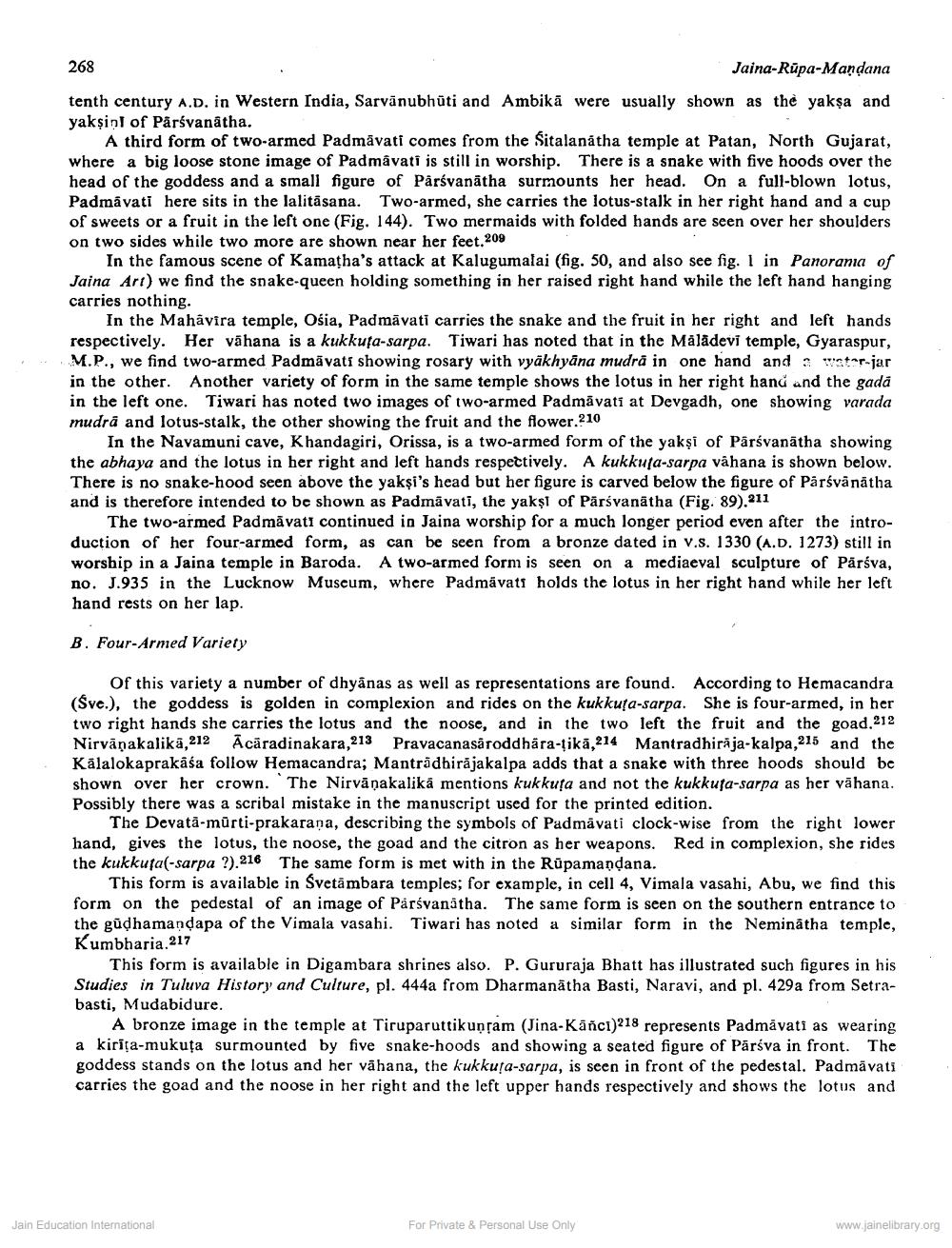________________
268
Jaina-Rupa-Mandana tenth century A.D. in Western India, Sarvānubhūti and Ambikā were usually shown as the yakşa and yakşinl of Pårsvanatha.
A third form of two-armed Padmăvati comes from the Sitalanátha temple at Patan, North Gujarat, where a big loose stone image of Padmavati is still in worship. There is a snake with five hoods over the head of the goddess and a small figure of Pårsvanātha surmounts her head. On a full-blown lotus, Padmavati here sits in the lalitäsana. Two-armed, she carries the lotus-stalk in her right hand and a cup of sweets or a fruit in the left one (Fig. 144). Two mermaids with folded hands are seen over her shoulders on two sides while two more are shown near her feet. 209
In the famous scene of Kamatha's attack at Kalugumalai (fig. 50, and also see fig. 1 in Panorama of Jaina Art) we find the snake-queen holding something in her raised right hand while the left hand hanging carries nothing.
In the Mahavira temple, Ośia, Padmāvati carries the snake and the fruit in her right and left hands respectively. Her vāhana is a kukkuta-sarpa. Tiwari has noted that in the Malādevi temple, Gyaraspur, M.P., we find two-armed Padmavati showing rosary with vyakhyāna mudrà in one hand and water-jar in the other. Another variety of form in the same temple shows the lotus in her right hand and the gada in the left one. Tiwari has noted two images of two-armed Padmavati at Devgadh, one showing varada mudra and lotus-stalk, the other showing the fruit and the flower.210
In the Navamuni cave, Khandagiri, Orissa, is a two-armed form of the yakşi of Pārsvanātha showing the abhaya and the lotus in her right and left hands respectively. A kukkuja-sarpa vahana is shown below. There is no snake-hood seen above the yakşi's head but her figure is carved below the figure of Pārsvanatha and is therefore intended to be shown as Padmāvati, the yakşi of Pārsvanātha (Fig. 89).211
The two-armed Padmăvati continued in Jaina worship for a much longer period even after the introduction of her four-armed form, as can be seen from a bronze dated in v.s. 1330 (A.D. 1273) still in worship in a Jaina temple in Baroda. A two-armed form is seen on a mediaeval sculpture of Pārsva, no. J.935 in the Lucknow Museum, where Padmavati holds the lotus in her right hand while her left hand rests on her lap.
B. Four-Armed Variety
of this variety a number of dhyānas as well as representations are found. According to Hemacandra (Sve.), the goddess is golden in complexion and rides on the kukkuta-sarpa. She is four-armed, in her two right hands she carries the lotus and the noose, and in the two left the fruit and the goad.212 Nirvāņakalikā,212 Ācāradinakara,213 Pravacanasároddhāra-ţikā,214 Mantradhiraja-Kalpa,215 and the Kalalokaprakasa follow Hemacandra; Mantrādhirajakalpa adds that a snake with three hoods should be shown over her crown. The Nirvāņakalika mentions kukkusa and not the kukkuja-sarpa as her vāhana. Possibly there was a scribal mistake in the manuscript used for the printed edition.
The Devata-murti-prakarana, describing the symbols of Padmavati clock-wise from the right lower hand, gives the lotus, the noose, the goad and the citron as her weapons. Red in complexion, she rides the kukkufa(-sarpa ?).216 The same form is met with in the Rūpamandana.
This form is available in Svetämbara temples; for example, in cell 4, Vimala vasahi, Abu, we find this form on the pedestal of an image of Parsvanatha. The same form is seen on the southern entrance to the gūdhamandapa of the Vimala vasahi. Tiwari has noted a similar form in the Neminátha temple, Kumbharia 217
This form is available in Digambara shrines also. P. Gururaja Bhatt has illustrated such figures in his Studies in Tuluva History and Culture, pl. 444a from Dharmanātha Basti, Naravi, and pl. 429a from Setrabasti, Mudabidure.
A bronze image in the temple at Tiruparuttikunsam (Jina-Kāñci)218 represents Padmavati as wearing a kirita-mukuța surmounted by five snake-hoods and showing a seated figure of Parśva in front. The goddess stands on the lotus and her vāhana, the kukkuta-sarpa, is seen in front of the pedestal. Padmavati carries the goad and the noose in her right and the left upper hands respectively and shows the lotus and
Jain Education International
For Private & Personal Use Only
www.jainelibrary.org




